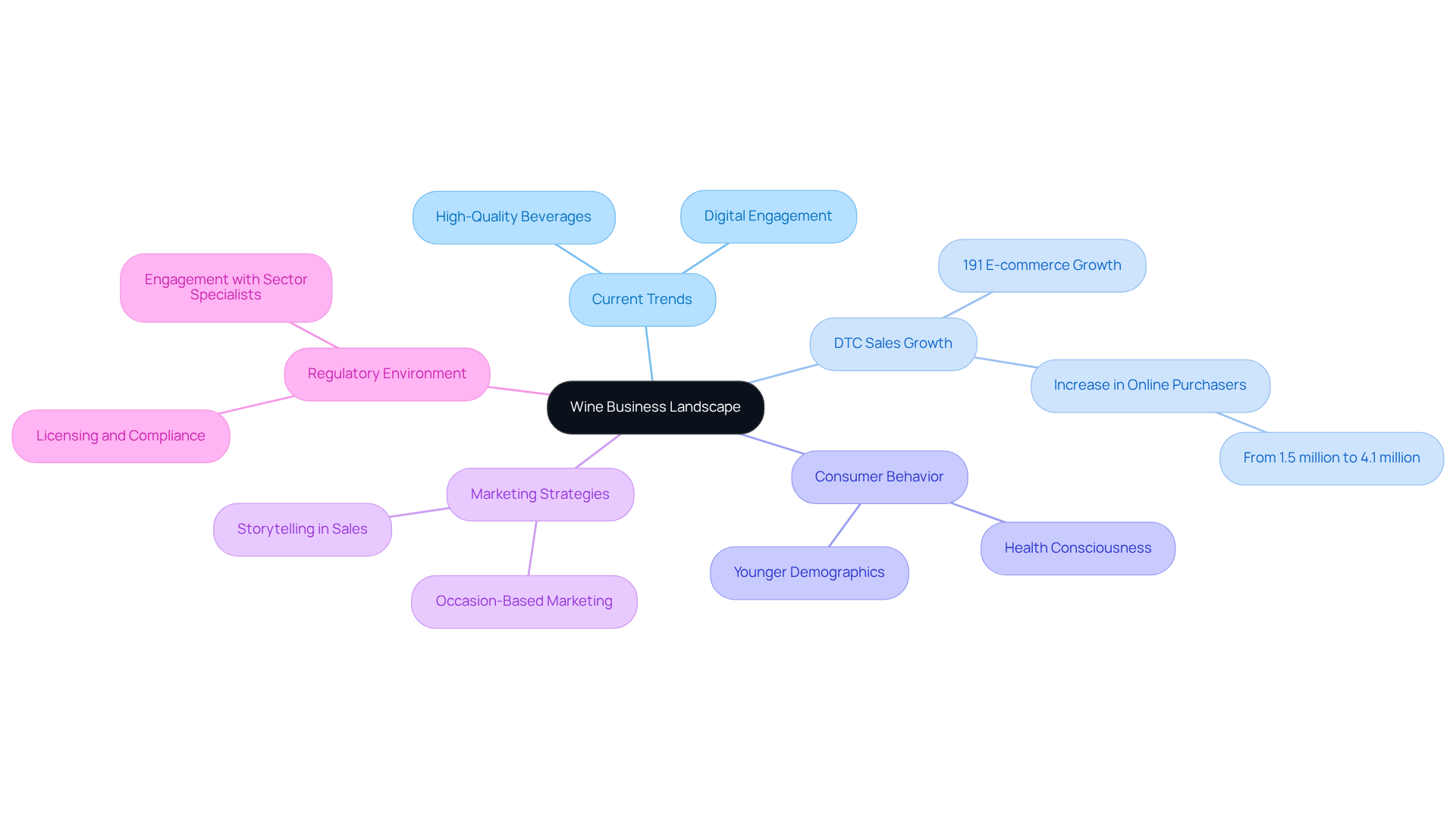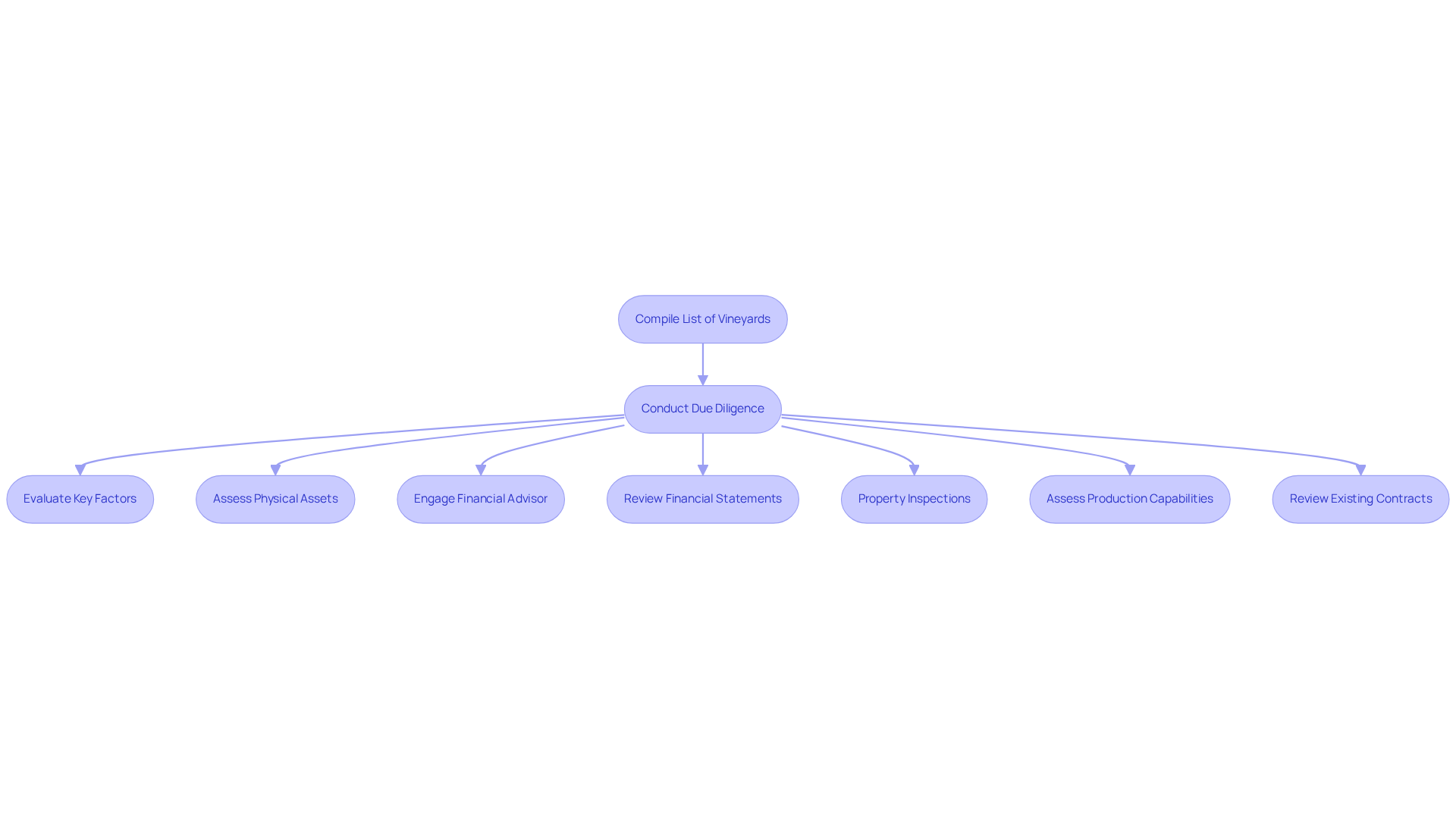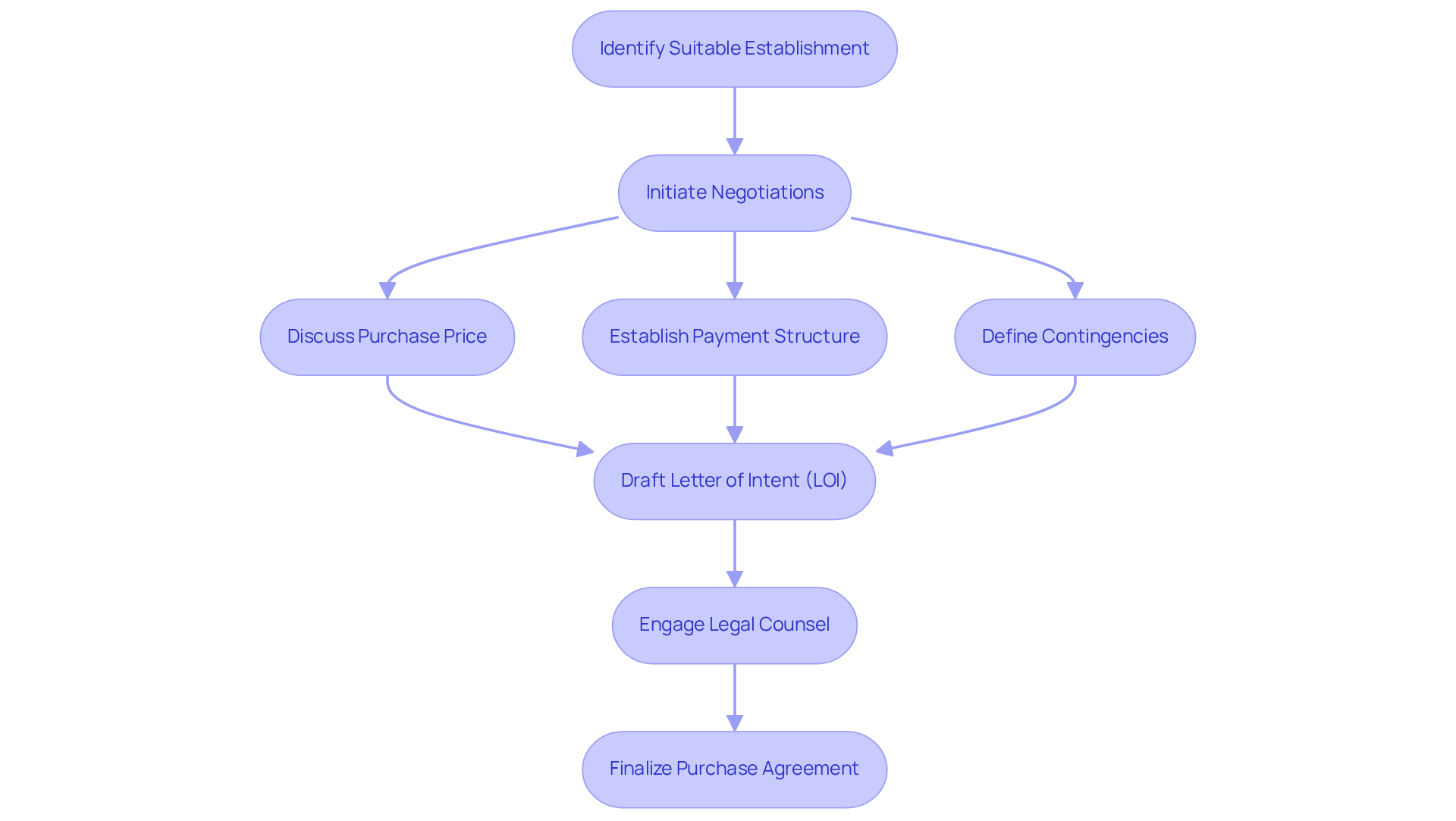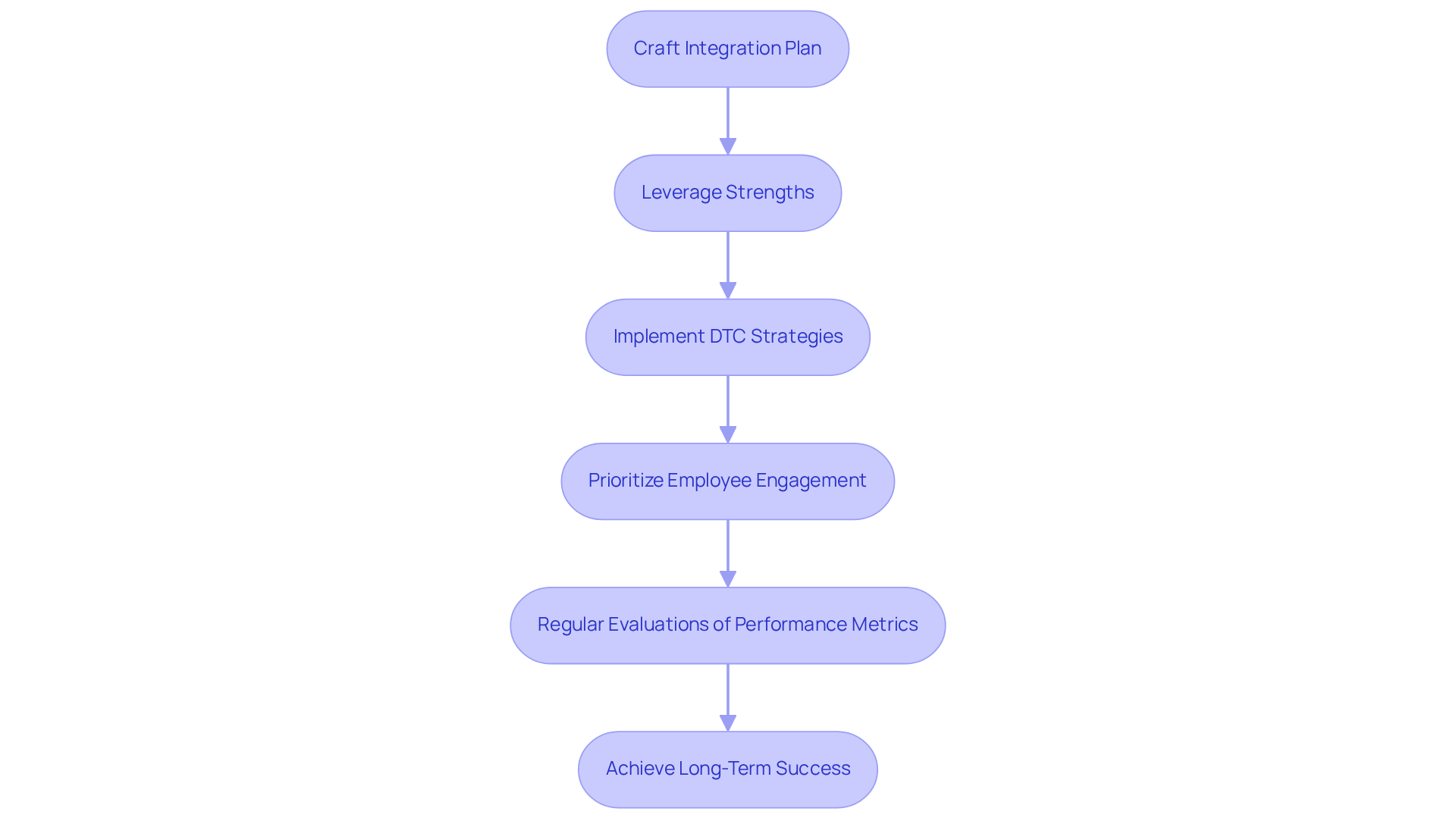Overview
To acquire a wine business for sale, mastering the industry landscape is paramount. This involves:
- Identifying potential businesses
- Negotiating favorable terms
- Strategizing for long-term success
The essential steps outlined in this article include:
- Leveraging direct-to-consumer sales
- Conducting thorough due diligence
- Crafting a robust integration plan
Collectively, these strategies ensure informed decision-making and sustainable growth in the competitive wine market. By understanding these critical elements, decision-makers can navigate the complexities of the industry with confidence and achieve their business objectives.
Introduction
Navigating the intricate world of the wine business presents both exhilarating opportunities and daunting challenges, particularly for aspiring entrepreneurs eager to leave their mark. In a rapidly evolving landscape influenced by shifting consumer preferences and innovative sales strategies, the window of opportunity to acquire a wine business is ripe for those ready to act decisively.
What essential steps must be taken to ensure a successful acquisition, and how can potential buyers effectively evaluate and integrate a new venture into their existing operations?
This guide explores the critical processes of identifying, negotiating, and successfully managing a wine business acquisition, offering invaluable insights for achieving long-term success in this dynamic industry.
Understand the Wine Business Landscape
To effectively acquire a beverage business, understanding the current landscape of the is paramount. Key trends, such as the rise of high-quality beverages and the increasing significance of direct-to-consumer (DTC) sales, have transformed the way producers engage with customers. In 2020, wineries that adopted DTC strategies experienced an impressive average e-commerce growth of 191%, underscoring the potential for significant revenue increases. Furthermore, the number of online beverage purchasers skyrocketed from 1.5 million to 4.1 million, highlighting the shift towards digital engagement.
Leveraging resources like market reports and analyses will provide insights into consumer preferences and competitive dynamics. For instance, the latest State of the US Wine Industry report indicates that occasion-based marketing campaigns aimed at consumers aged 30 to 45 can effectively counteract declines in the aging Boomer segment, which is projected to peak between 2029 and 2031.
Additionally, comprehending the regulatory environment is crucial, as licensing and compliance requirements can vary considerably by region. Engaging with sector specialists and participating in trade exhibitions can yield valuable insights into market conditions and emerging opportunities, enabling informed decision-making in this evolving landscape. As the beverage market continues to adapt to shifting consumer attitudes and preferences, particularly among younger demographics, a proactive strategy for DTC sales and innovative marketing techniques will be vital for achieving sustainable growth.

Identify and Evaluate Potential Wine Businesses
Start by compiling a comprehensive list of through various channels, including sector listings, real estate websites, and networking within the beverage community. After identifying suitable candidates, conduct thorough due diligence that encompasses not only the examination of financial statements and operational efficiency but also the strategic capital planning essential for sustainable growth.
Key factors to evaluate include:
- Existing customer relationships
- Brand reputation
- Growth potential, especially through direct-to-consumer channels that can convert casual buyers into devoted club members
Specific strategies may involve:
- Executing targeted marketing campaigns
- Optimizing online sales platforms
- Crafting engaging customer experiences that cultivate loyalty
Furthermore, assess the physical assets involved, such as vineyards, equipment, and inventory. Engaging a financial advisor or business broker with expertise in the wine industry can significantly enhance your evaluation process when considering a wine business for sale, ensuring informed decision-making.
For instance, understanding financial performance indicators, like cash flow and profitability ratios, is crucial in 2025, as vineyards face increasing operational expenses and market fluctuations. A detailed due diligence checklist should encompass:
- Property inspections
- Assessments of production capabilities
- Reviews of existing contracts that may impact future operations
By adhering to these best practices and exploring strategic capital opportunities, including those provided by Enocap, you can adeptly navigate the complexities of acquiring a winery and position yourself for long-term success.

Negotiate Terms and Finalize the Purchase Agreement
Upon identifying a suitable establishment, initiate negotiations by clearly defining your objectives and comprehending the seller's motivations. Key terms for discussion include:
- The purchase price
- Payment structure
- Any contingencies
Transparency regarding your intentions is crucial; it fosters rapport with the seller, facilitating a smoother negotiation process. Draft a letter of intent (LOI) that outlines the agreed-upon terms, serving as a preliminary agreement prior to the creation of the final purchase agreement. Engaging legal counsel with expertise in transactions involving a wine business for sale is advisable to ensure compliance with local regulations and the proper transfer of licenses.
Once both parties are satisfied with the terms, finalize the purchase agreement, ensuring it encompasses all necessary details regarding the transfer of ownership and any post-sale obligations. In 2025, the average acquisition cost for vineyards has seen significant appreciation, indicating the increasing interest in the wine business for sale. Understanding —such as representations and warranties, indemnification clauses, and conditions precedent—is essential for a successful transaction.
Additionally, expert insights on drafting a letter of intent can streamline the acquisition process, laying a solid foundation for negotiations. Case studies of successful purchase agreements in the beverage sector underscore the importance of thorough due diligence and strategic planning, ultimately leading to favorable outcomes for both buyers and sellers.

Integrate and Strategize for Long-Term Success
Post-acquisition, it is imperative to focus on the seamless integration of the new business into your existing operations. Begin by crafting a detailed integration plan that prioritizes branding, marketing, and customer engagement. Leverage the strengths of the acquired establishment, such as its unique wine offerings and established customer base, to enhance your overall brand narrative in the context of the wine business for sale. Implement robust direct-to-consumer (DTC) strategies utilizing digital marketing and social media to boost visibility and drive sales. Employee engagement and retention must also be prioritized during this transition, as maintaining high morale is crucial for a smooth operational shift.
Regular evaluations of performance metrics are essential to ensure alignment with market trends and consumer preferences, allowing for timely adjustments to your strategy. For instance, consider Chateau Montelena's recent acquisition of a 73-acre vineyard, which exemplifies how a wine producer can elevate its brand by focusing on quality and innovation. Their plan to plant in 2026 not only secures their legacy but also refines their flagship Chardonnay, historically a benchmark in the industry. Such strategic moves underscore the significance of a in achieving long-term success post-acquisition.
By incorporating these practices, you position your winery for sustainable growth, ensuring that the integration of new assets contributes positively to your brand's evolution and market presence.

Conclusion
Mastering the acquisition of a wine business demands a thorough understanding of the current landscape, strategic evaluation of potential candidates, effective negotiation, and successful integration post-purchase. By grasping the nuances of the beverage industry, including emerging trends and consumer preferences, prospective buyers position themselves to make informed decisions that lead to sustainable growth.
Critical steps in this process include:
- Analyzing market trends
- Identifying potential businesses for sale
- Conducting thorough due diligence
- Negotiating favorable terms
The significance of direct-to-consumer strategies and innovative marketing techniques cannot be overstated; these are essential for enhancing brand presence and driving sales in an increasingly competitive market. The integration phase stands out as a pivotal moment, offering opportunities to leverage the strengths of the acquired business and foster long-term success.
Ultimately, acquiring a wine business transcends mere transaction; it presents an opportunity to craft a narrative that resonates with consumers and builds lasting relationships. By implementing the strategies discussed, aspiring wine entrepreneurs can adeptly navigate the complexities of acquisition, emerging with a thriving business poised for future success. Embrace the challenge, stay informed, and take decisive action to transform the dream of owning a wine business into a reality.
Frequently Asked Questions
Why is it important to understand the beverage business landscape when acquiring a beverage business?
Understanding the beverage business landscape is crucial because it reveals key trends, such as the rise of high-quality beverages and the increasing importance of direct-to-consumer (DTC) sales, which have transformed producer-customer engagement.
What impact did DTC strategies have on wineries in 2020?
Wineries that adopted DTC strategies in 2020 experienced an average e-commerce growth of 191%, indicating significant potential for revenue increases.
How has the number of online beverage purchasers changed recently?
The number of online beverage purchasers increased dramatically from 1.5 million to 4.1 million, demonstrating a significant shift towards digital engagement in the beverage industry.
What resources can help in understanding consumer preferences and competitive dynamics in the beverage industry?
Resources such as market reports and analyses can provide valuable insights into consumer preferences and competitive dynamics within the beverage industry.
What does the latest State of the US Wine Industry report suggest about targeting consumers?
The report suggests that occasion-based marketing campaigns aimed at consumers aged 30 to 45 can effectively counteract declines in the aging Boomer segment, which is expected to peak between 2029 and 2031.
Why is it important to comprehend the regulatory environment in the beverage industry?
Comprehending the regulatory environment is important because licensing and compliance requirements can vary significantly by region, impacting business operations.
How can engaging with sector specialists and participating in trade exhibitions benefit beverage businesses?
Engaging with sector specialists and participating in trade exhibitions can provide valuable insights into market conditions and emerging opportunities, enabling informed decision-making.
What strategies are vital for achieving sustainable growth in the evolving beverage market?
A proactive strategy for DTC sales and innovative marketing techniques are vital for achieving sustainable growth as the beverage market adapts to shifting consumer attitudes and preferences, particularly among younger demographics.




